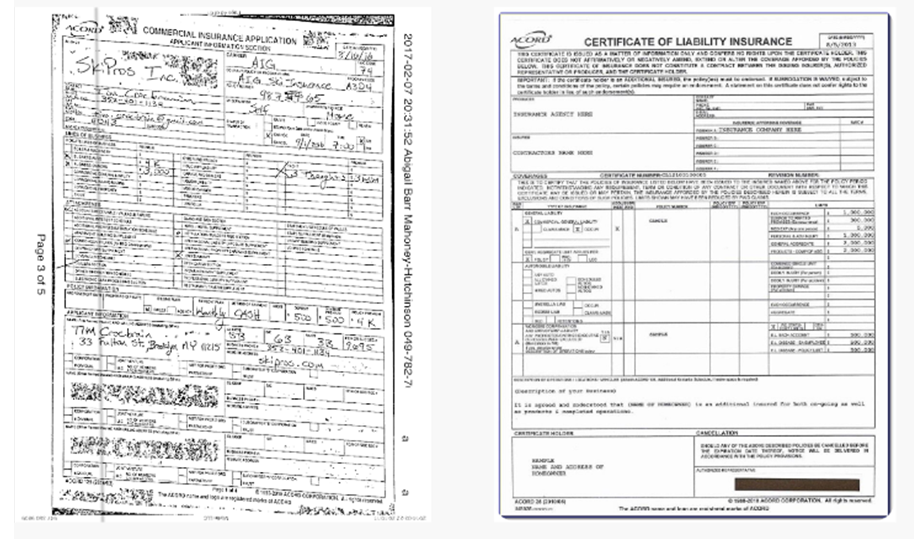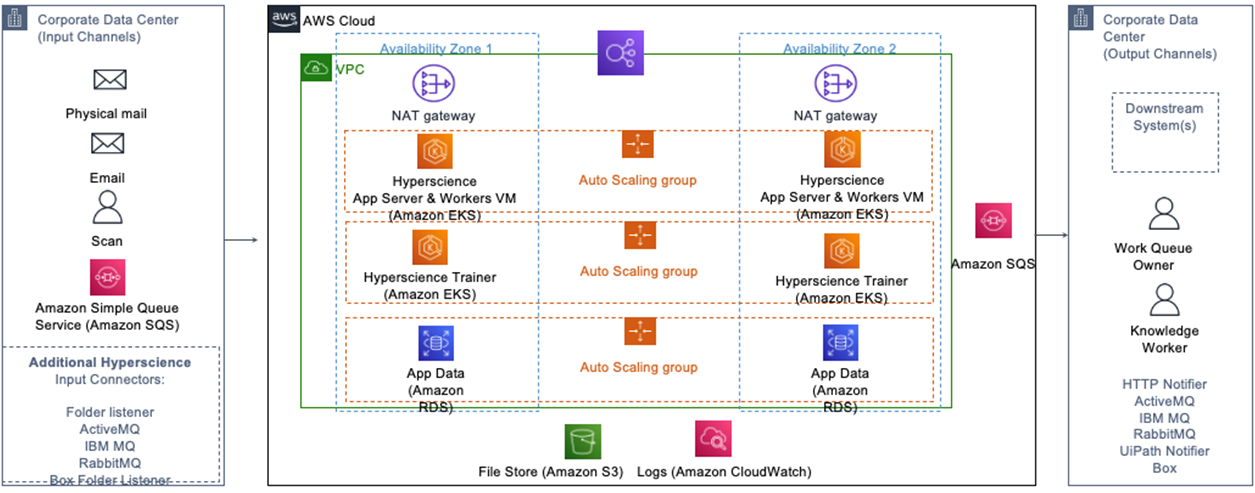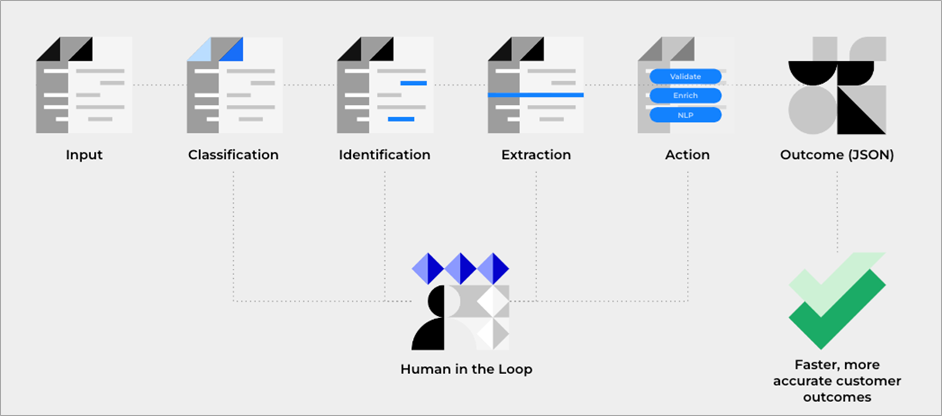AWS Partner Network (APN) Blog
How Hyperscience Modernizes Insurance Operations with Intelligent Automation on AWS
By Chintan Sanghavi, Sr. Partner Solutions Architect – AWS
By Tim Wikander, Director of Global Alliances – Hyperscience
 |
| Hyperscience |
 |
Increased competition, labor shortages, and changing customer expectations have forced organizations to rethink their document-based processes.
Additionally, recent market changes spurred by the pandemic have only increased the sense of urgency. In their efforts to become more resilient and adaptable, organizations are exploring ways to accelerate digital transformation, seeking a competitive advantage that will protect against future unexpected changes.
Insurance agencies are no exception, making intelligent document processing (IDP) critical for streamlining manual processes, meeting customer expectations, and staying ahead of the competition.
In this post, we’ll cover how Hyperscience addresses the limitations of legacy automation solutions to help insurance agencies optimize document processing. We’ll also explore how incorporating machine learning (ML) into automation solutions leads to greater end-to-end automation, more engaging work, and better business outcomes.
Hyperscience is an AWS Partner whose automation technology helps data-centric companies parse through vast amounts of unstructured inputs and raw information to get to swifter and smarter business decisions.
Limitations of Legacy Automation Solutions
The insurance industry is constantly changing, and traditional automation solutions such as optical character recognition (OCR) or robotic process automation (RPA) often fail to advance digital transformation initiatives.
Additionally, current automation approaches fail to unlock human potential when it’s needed most. Early rules-based automation technologies struggle to cope with unexpected surges in volume, complex use cases, or changing market conditions.
A good example of use case complexity in the insurance space can be observed with ACORD forms. These forms are primarily used within property and casualty, life and annuity, surety, and reinsurance markets. Though the layout of these forms is standardized, it’s common for them to contain a mix of typed and handwritten text.
The images below show the same ACORD form, but filled out and submitted via different means, leading to a variation in quality that can be difficult for OCR and robotic process automatio (RPA) to process accurately.
Figure 1 – RPA and OCR struggle with low image quality.
On the left, the form above has been completed by hand and then scanned (note the document skew and scan lines) before submission. On the right, the form was completed electronically. For traditional OCR solutions, this variation in quality leads to an increased likelihood of errors.
The variability of the forms, quantity of handwriting, checkboxes, and frequent addition of new fields make it difficult for legacy or rules-based OCR technology to process.
Solution Overview
Hyperscience seeks to unite human and artificial intelligence (AI) and machine learning to solve tomorrow’s automation challenges today, creating better outcomes for customers, companies, and the world.
To accomplish this, the Hyperscience platform offers ML-based document processing, turning the data trapped within documents into actionable information that enables better, faster decision making.
Hyperscience moves beyond simple character recognition to understand the context of documents within the insurance industry. This contextual understanding accelerates the processing of structured (like ACORD forms), semi-structured, and unstructured documents.
The Hyperscience platform also enables enterprises to handle complex handwritten and typed use cases, thereby accelerating processes, mitigating costs, and freeing up talent to focus on high-value work. Eliminating the heavy demand for document processing and data entry enables insurance businesses to create a simplified customer experience.
Reference Architecture
Below is the Hyperscience architecture on Amazon Web Services (AWS) and how it can be deployed. Many customers enjoy the ability to expand their use of existing AWS services to get up and running faster while maximizing return on investment (ROI).
Figure 2 – Hyperscience reference architecture and how it can be deployed.
The Hyperscience platform is a fully managed, highly-available, SOC 2 Type II certified, software-as-a-service (SaaS) solution available on AWS Marketplace.
The application is containerized and can be deployed in your organization’s private cloud using Amazon Elastic Kubernetes Service (Amazon EKS). Its modular architecture allows the application to be scaled horizontally by simply adding new nodes to the Kubernetes cluster. This allows Hyperscience to be scaled up for high-volume use cases to process millions of documents daily.
The deployment can be configured to use AWS resources (Amazon RDS for database, Amazon S3 for file storage, and Amazon SQS for document ingestion and output of extracted data) across multiple AWS Availability Zones (AZs) for high availability.
Powered by machine learning, the Hyperscience platform is flexible enough to automate any type of document process from input to actionable data with ease:
- Input: An intuitive user interface (UI) allows users to easily set up and manage the processing of all document types, including structured, semi-structured, and unstructured forms and handwritten text. As an input source, Hyperscience can ingest scanned documents from an S3 bucket, Amazon SQS, or via email. Likewise, Hyperscience provides the ability to integrate with external systems through various connectors and APIs.
- Classification: Hyperscience accurately classifies all document types, making managing high volumes of document variations easy and fast.
- Extraction: Proprietary ML technology extracts data from complex documents with up to 99.5% accuracy. Users are also able to set their own desired accuracy levels. The image below details Hyperscience’s extraction capabilities with handwritten text.
Figure 3 – Hyperscience uses ML to accurately identify and extract handwritten text.
- Action: Hyperscience enables users to drive business outcomes, routing extracted data through bespoke workflows to apply validation, enrichment, case collation, keyword search, or more advanced natural language processing (NLP).
- Supervision: Hyperscience builds “human in the loop” into every stage of the process with a streamlined task queue and easy-to-use interface designed to empower teams and continually improve ML performance over time.
- Integrations: Hyperscience integrates out of the box with leading software providers to automate end-to-end business processes, providing accurate, actionable data where you need it most.
- Insights: Get visibility into extraction performance with out-of-the-box reports such as automation and accuracy levels, throughput, or usage information.
Human-in-the-Loop
Harvard Business Review reported that an analysis of 1,500 companies implementing AI within their organizations found that organizations which tried to outright replace humans with machines only experienced short-term gains. The report states that companies that “had humans and machines working alongside each other had the greatest success.”
So how do organizations encourage human-machine collaboration? This is the concept of “human in the loop,” where humans and machines share responsibilities.
Humans teach and provide input so the machine learning models can grow more independent over time. With AI taking on the role of “helper” rather than replacement, successful machine-human collaboration with tomorrow’s digital workforce will be central to the future of work.
The graphic below shows the typical document processing workflow. The tasks labeled human in the loop indicate steps where a human can provide input to train the machine learning model.
Figure 4 – Hyperscience approach to human in the loop.
Hyperscience uses machine learning to involve humans only when necessary during any step of document processing. For example, if the machine is unsure during transcription, where it reads an alpha character in a field expecting only digits, such as for an NAIC code on an ACORD 125, it sends the specific field to supervisors to review and resolve. Those responses help fine-tune the underlying ML models to drive higher automation performance.
For businesses, this means less human involvement, greater automation, and more time to focus on value-add activities that drive the business forward.
Prioritizing Accuracy
Most business processes start with some sort of document or data input (such as policy applications, claim forms, death claims, purchase orders, and invoices) that comes in a wide variety of formats.
PDFs, emails, images, and other unstructured document formats connect customers with companies and citizens with government agencies, but this valuable knowledge is locked in formats machines can’t understand—it must be accurately (and efficiently) processed to extract the data for downstream usage.
Machine learning bridges this gap, turning unstructured data into structured, machine-readable data without significant human intervention. Having accurate, complete data is the critical first step of process automation; it helps reduce costs and errors and improves your time to decision-making.
To maintain the highest levels of accuracy, Hyperscience’s ML models are periodically re-trained with the latest data available.
Optimized for Flexibility and Scalability
Hyperscience is built to grow with your organization. Its customers are unique with diverse tech stacks and dynamic business processes. Modularity and ease of integration are critical to helping organizations maximize the return on existing automation investments and make operations more agile and responsive to future market factors.
With the Hyperscience platform, employees help customize and train ML models according to a company’s specific processes. For organizations facing a skilled labor shortage, this unlocks the ability to complete higher-value work with the same (or fewer) resources. It also shapes your business into a digital, agile workforce that evolves to meet future market needs.
Most importantly, for your customers, the result is fewer clerical errors, faster decision-making, and a better customer experience overall.
The following graphic demonstrates how Hyperscience is built for scalability.

Customer Success Stories
A Fortune 500 insurance company had done things in the same way for decades. After all those years, it had amassed multiple legacy systems to handle processing needs.
The problem? The company’s existing RPA solution struggled to accurately extract data from invoices. These documents contained handwritten notes, stamps, and fax marks—imperfections that resulted in low processing accuracy, leading to further manual review and correction.
It needed a solution that supported the extraction of data from the handwritten invoices from small vendors as well as the multi-page documents provided by much larger corporations, but RPA just couldn’t keep up with the high variability of these documents.
By bolstering its RPA solution with Hyperscience, an intelligent document processing solution, the company was able to unlock the data previously trapped in unstructured documents.
This helped the organization better prepare for the future. Instead of being locked into the rigid template design of RPA, it harnessed the power of Hyperscience’s proprietary machine learning models. Employees learned to train ML models to recognize layout changes, and the company significantly decreased document processing times.
With forms that require such high levels of accuracy, eliminating mistakes is a must. Every mistake equated to more lost time and disgruntled customers, and even undermined trust in the existing automation solution.
With Hyperscience, the insurance firm was able to:
- Define its preferred accuracy target and automate accordingly.
- Harness the power of machine learning in tandem with human decision-making.
- Improve accuracy for handwritten text and low-resolution images.
Using the Hyperscience platform, this firm reached 98.5% accuracy in document processing. By boosting accuracy levels, it was able to stay ahead of customer demand during peak season, bringing response times down and keeping customers happier.
Additionally, the improvements in customer care helped this organization overtake their competitors in the marketplace.
Conclusion
Through a human-centered approach, the Hyperscience platform helps transform how you approach and prioritize work, resulting in fewer mistakes and faster decisions, better access to services, happier customers, and increased employee satisfaction.
Hyperscience helps organizations and government agencies around the world automate core processes, positively impacting the lives of millions. Its customers can approve insurance claims faster, pay vendor invoices on time, and provide citizens with improved, timely services, all while reducing manual labor.
To get started, check out the Hyperscience platform on AWS Marketplace.
Hyperscience – AWS Partner Spotlight
Hyperscience is an AWS Partner whose automation technology helps data-centric companies parse through vast amounts of unstructured inputs and raw information to get to swifter and smarter business decisions.




